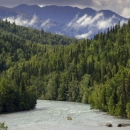Facility
Location
Ski Hill Road PO Box 2139
Soldotna, AK 99669
United States
Volunteer Position Overview
About This Position
Hosts help visitors in a variety of ways. They share Refuge wildlife, recreation, and regulatory information with visitors. They staff the Refuge Visitor Center, greeting visitors, answering their questions, giving recommendations and directions, and delivering pop-up interpretive programs to interested guests. Hosts will also answer the phone and operate a blu-ray player and media system to play nature videos for visitors. Hosts work a five-day workweek, with days off falling on weekdays.
Duties/Activities
Stories About Volunteering
Other Ways to Work with Us
Are you looking for something different than a volunteer opportunity? The Fish and Wildlife Service employs around 9,000 people nationwide and offers great internship opportunities every year.







